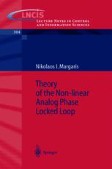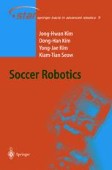Search
Search Results
-

-
14. Third harmonic sychronization
In this chapter we will present a brief analysis of the synchronization at the third harmonic of the center VCO frequency for the third order type-II...
-
9. Introduction to second order type – II PLL
In the second order type-II loop the filter is active and specifically a PI controller. This loop is considered superior to the second order type-I...
-
Appendix
In this appendix, we collect some useful mathematical inequalities and lemmas which have been extensively used throughout the book.
-
12. APPLICATION OF DUAL CONTROLLERS TO A LABORATORY SCALE VERTICAL TAKE-OFF AIRPLANE
The application of dual control with direct adaptation to the roll-angle control of a laboratory scale vertical take-off airplane (Patra et al.,...
-
Linear map**s on ordered vector spaces
Before we can start to analyze the generalized Riccati operators derived in the previous chapter, we have to deal with generalized Lyapunov operators...
-
Main concepts and definitions
The dynamic system concept. One of the major results of the theoretical cognitive process is the possibility to evaluate the consequences of...
-
RTLinux-Based Controller for the SuperMARIO Mobile Robot
In the last years a new way to implement Real Time control systems has been opened, in connection with the diffusion of the open-source operating...
-
6 Conclusion
Controllable underactuated manipulators were successfully developed based on the nonlinear control theoretic approach. The nonholonomic gear is...
-
4 Design of the chained form manipulator
Nonholonomic underactuated systems are typically modelled as highly nonlinear ones, which becomes obvious as the dimension of the system increases....
-
Extremal Properties of Random Structures
The extremal characteristics of random structures, including trees, graphs, and networks, are discussed. A statistical physics approach is employed...
-
On the Analysis of Backtrack Proceduresfor the Colouring of Random Graphs
Backtrack search algorithms are procedures capable of deciding whether a decision problem has a solution or not through a sequence of trials and...
-
Attacks and Cascades in Complex Networks
This paper reviews two problems in the security of complex networks: cascades of overload failures on nodes and range-based attacks on links....
-
Tomography and Stability of Complex Networks
We study the structure of generalized random graphs with a given degree distribution P(k), and review studies on their behavior under both random...
-
Topology, Hierarchy, and Correlations in Internet Graphs
We present a statistical analysis of different metrics characterizing the topological properties of Internet maps, collected at two different...
-
The Small World Phenomenonin Hybrid Power Law Graphs
The small world phenomenon, that consistently occurs in numerous existing networks, refers to two similar but different properties — small average...
-
4. How to Decide and Act? Use Intelligent Systems and Control Techniques
In robot soccer, the game situation in the playground is typically read in terms of the robots’ postures and the ball’s position. Using real-time...
-
Analysis of maximum control error
Problem definition. Maximum (or practically maximum – see §2.4) error is the most objective characteristic of control accuracy in many cases....
-
On The Problem of Simultaneous Localization, Map Building, and Servoing of Autonomous Vehicles
In this chapter, we consider three of the main problems that arise in the navigation of autonomous vehicles in partially or totally unknown...
-
Model-Based Friction Compensation
Compensation of nonlinear friction terms is a most challenging application of high resolution encoders, which are nowadays getting available for...
